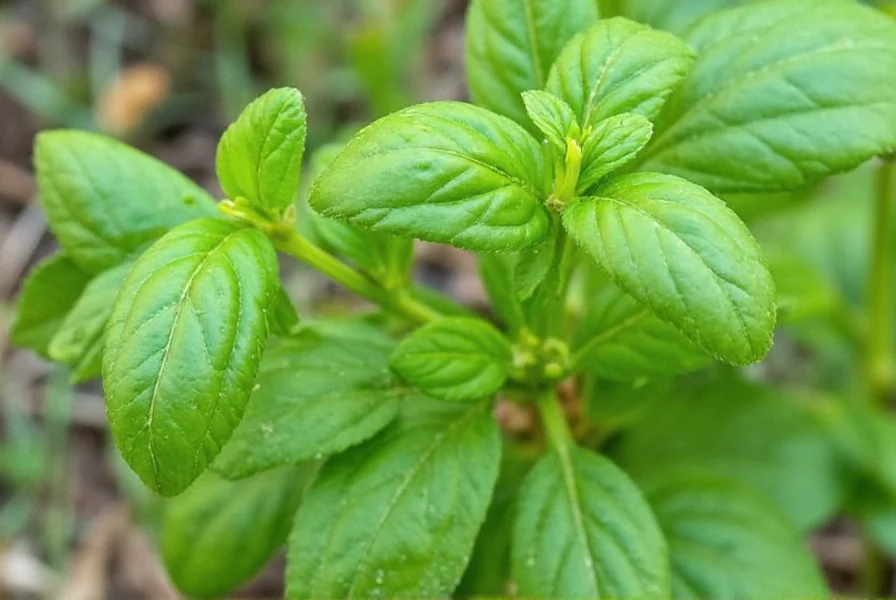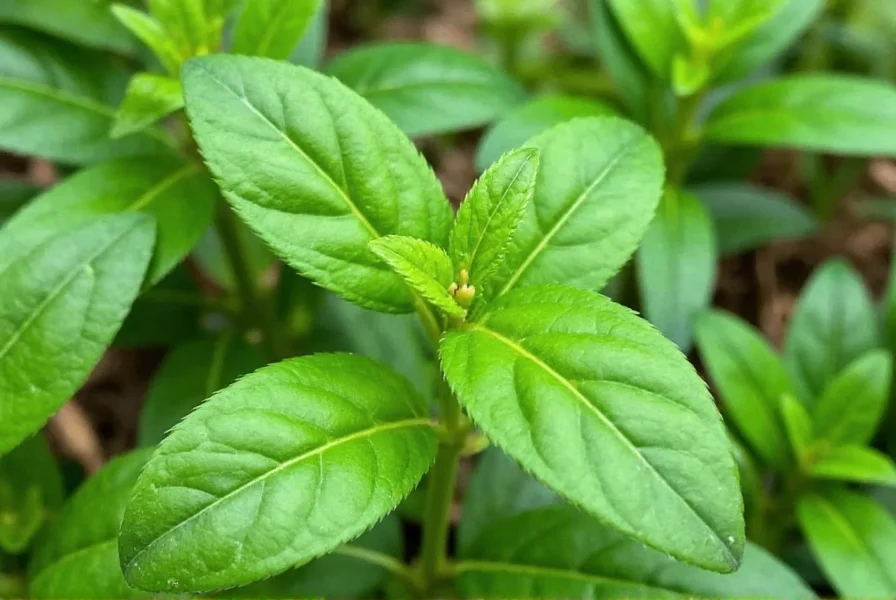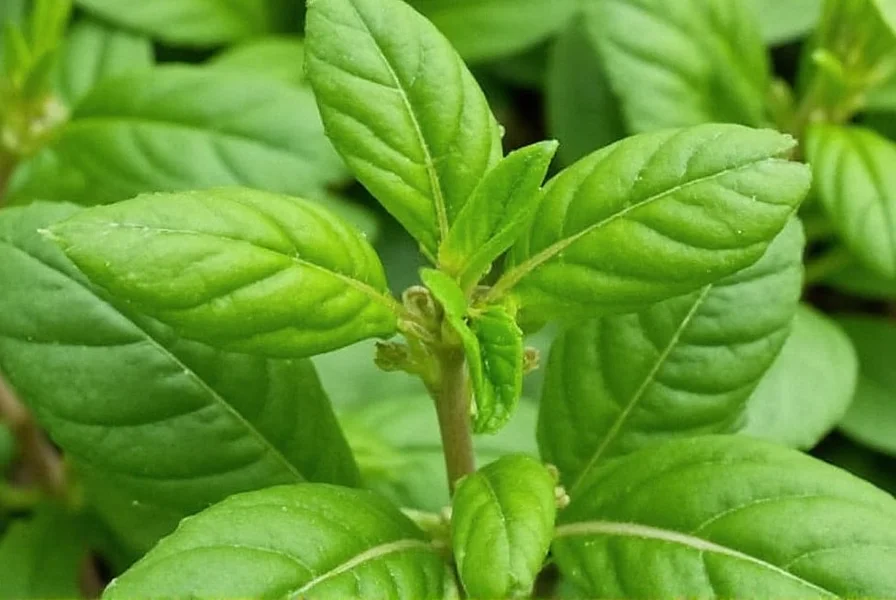| Characteristic | Cinnamon Basil | Sweet Basil |
|---|---|---|
| Flavor Profile | Spicy, warm, cinnamon-clove notes | Sweet, peppery, anise undertones |
| Leaf Color | Green with burgundy veins | Uniform green |
| Stem Color | Purple to burgundy | Green |
| Flower Color | Magenta | White to pale pink |
| Best Culinary Uses | Fruit salads, Mexican dishes, teas | Pasta, pizza, caprese salads |
Understanding Cinnamon Basil's Unique Characteristics
Cinnamon basil stands apart from other basil varieties through its distinctive chemical composition. While sweet basil contains high levels of linalool and eugenol, cinnamon basil's essential oil profile features significant amounts of methyl cinnamate (up to 70%), creating its signature warm, spicy aroma. This unique compound ratio makes it particularly valuable for specific culinary applications where traditional basil would be inappropriate.
Gardeners often select cinnamon basil not only for its flavor but also for its ornamental qualities. The plant typically grows 12-18 inches tall with a compact, bushy habit. Its small, narrow leaves have a velvety texture and develop more pronounced burgundy coloring when exposed to full sun. The magenta flower spikes attract beneficial pollinators while adding visual interest to herb gardens.
Culinary Applications of Cinnamon Basil
When incorporating cinnamon basil into recipes, understanding its flavor dynamics proves essential for successful results. Unlike sweet basil which pairs well with tomatoes and Italian cuisine, cinnamon basil's warm notes complement:
- Fruit-based dishes like strawberry-balsamic salads and peach salsas
- Mexican and Southwestern cuisine, particularly in mole sauces
- Chocolate desserts and beverages
- Herbal teas and infused waters
- Spiced fruit preserves and chutneys
Chefs recommend using cinnamon basil sparingly at first, as its flavor can dominate other ingredients. The leaves work best when added toward the end of cooking to preserve their delicate aromatic compounds. For optimal flavor extraction in beverages, gently bruise the leaves before steeping.

Growing Cinnamon Basil Successfully
Cultivating cinnamon basil follows similar principles to growing other basil varieties but with some specific considerations. This herb thrives in full sun (6-8 hours daily) and well-draining soil with a pH between 6.0-7.5. Unlike sweet basil which may bolt quickly in heat, cinnamon basil demonstrates better heat tolerance, making it suitable for warmer climates.
For best results when growing cinnamon basil:
- Start seeds indoors 4-6 weeks before last frost or sow directly after soil reaches 70°F
- Maintain consistent moisture without waterlogging (1-1.5 inches weekly)
- Pinch off flower buds to encourage bushier growth and prolong leaf production
- Apply light organic fertilizer every 3-4 weeks during growing season
- Space plants 12-18 inches apart to ensure proper air circulation
One notable advantage for gardeners is cinnamon basil's natural resistance to common basil pests like Japanese beetles. The same compounds that create its distinctive flavor also serve as natural deterrents, reducing the need for pest control interventions.
Harvesting and Preserving Cinnamon Basil
Timing your harvest correctly maximizes both flavor and plant productivity. For optimal essential oil concentration, harvest cinnamon basil in the morning after dew evaporates but before midday heat. The ideal stage is when plants reach 6-8 inches in height with multiple sets of leaves.
Unlike sweet basil which loses much of its flavor when dried, cinnamon basil retains more of its characteristic aroma through proper preservation:
- Air drying: Hang small bundles upside down in a dark, well-ventilated space
- Freezing: Chop leaves and freeze in ice cube trays with water or olive oil
- Vinegar infusions: Create flavorful herb vinegars for dressings
- Salt preservation: Layer leaves with coarse salt for long-term storage
When storing fresh cinnamon basil, avoid refrigeration which can cause blackening. Instead, treat it like cut flowers—place stems in water at room temperature and change water daily. Properly stored, fresh leaves remain viable for 7-10 days.

Substituting Cinnamon Basil in Recipes
Understanding when and how to substitute cinnamon basil proves valuable when following recipes. While not a direct replacement for sweet basil, it works well in specific applications:
- Use 1:1 in fruit-based recipes where warm spice notes enhance the dish
- Substitute half cinnamon basil and half sweet basil in tomato-based dishes
- Replace mint in chocolate recipes for a more complex flavor profile
- Use sparingly in place of cinnamon in savory applications for freshness
Cooks should avoid substituting cinnamon basil in traditional Italian dishes where sweet basil's anise notes are essential. The warm spice profile would clash with expected flavor balances. Instead, reserve cinnamon basil for recipes specifically designed to highlight its unique characteristics or where its warmth complements other ingredients.
Frequently Asked Questions
What makes cinnamon basil different from regular basil?
Cinnamon basil contains high levels of methyl cinnamate (up to 70% of its essential oil composition), creating its distinctive warm, spicy flavor reminiscent of cinnamon and clove. It also features purple stems, burgundy-veined leaves, and magenta flowers unlike the uniform green appearance of sweet basil varieties.
Can I use cinnamon basil in place of sweet basil in pesto?
While possible, cinnamon basil creates a dramatically different pesto flavor profile. For traditional pesto, use no more than 25% cinnamon basil blended with sweet basil. The warm spice notes work better in fruit-based pestos or with chocolate for dessert applications rather than classic Italian preparations.
Does cinnamon basil have medicinal properties?
Traditional medicine systems have used cinnamon basil for digestive support and as an anti-inflammatory agent. Modern research shows its essential oils possess antimicrobial properties, though scientific evidence for specific health benefits remains limited compared to sweet basil varieties.
How do I prevent my cinnamon basil from flowering too quickly?
Regularly pinch off flower buds as soon as they appear to encourage leaf production. Maintain consistent moisture (without waterlogging), provide 6-8 hours of direct sunlight, and harvest leaves weekly to promote bushier growth. Avoid high-nitrogen fertilizers which accelerate flowering.
Is cinnamon basil safe for pets?
Cinnamon basil is generally safe for most pets in small quantities, but should not be fed regularly. The essential oils can cause digestive upset in cats and dogs if consumed in large amounts. Keep plants out of reach of curious pets, as excessive consumption may lead to vomiting or diarrhea.











 浙公网安备
33010002000092号
浙公网安备
33010002000092号 浙B2-20120091-4
浙B2-20120091-4